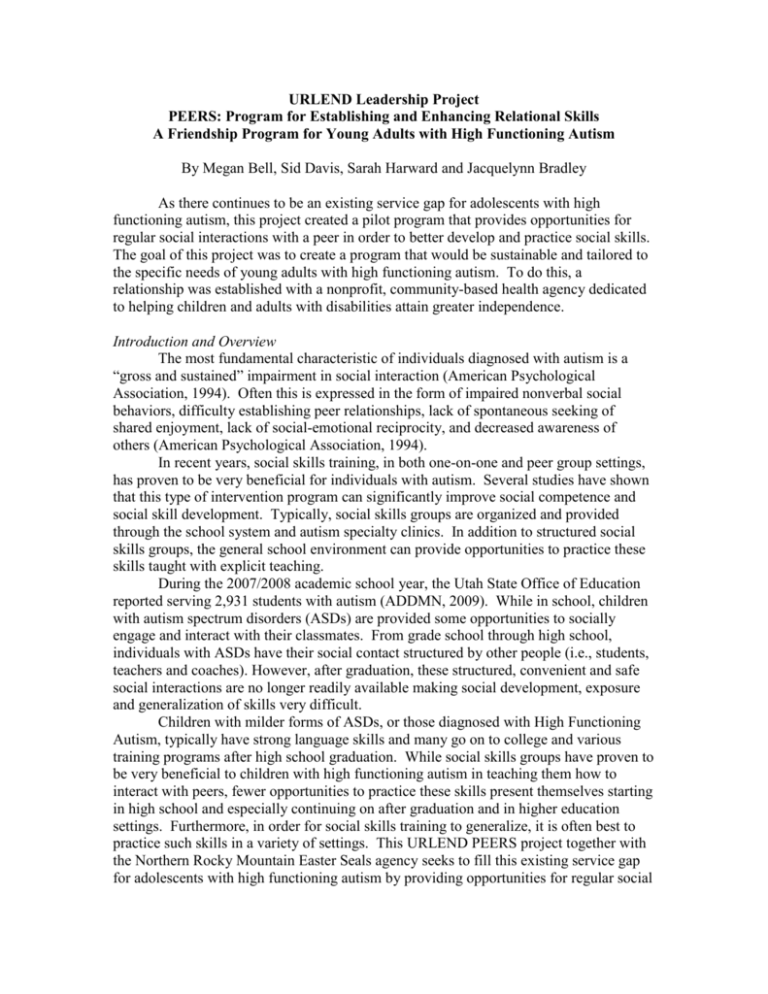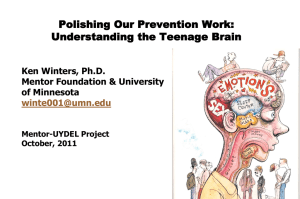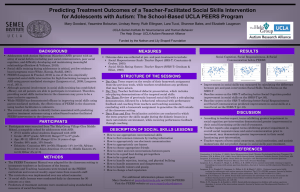Paper - URLEND
advertisement

URLEND Leadership Project PEERS: Program for Establishing and Enhancing Relational Skills A Friendship Program for Young Adults with High Functioning Autism By Megan Bell, Sid Davis, Sarah Harward and Jacquelynn Bradley As there continues to be an existing service gap for adolescents with high functioning autism, this project created a pilot program that provides opportunities for regular social interactions with a peer in order to better develop and practice social skills. The goal of this project was to create a program that would be sustainable and tailored to the specific needs of young adults with high functioning autism. To do this, a relationship was established with a nonprofit, community-based health agency dedicated to helping children and adults with disabilities attain greater independence. Introduction and Overview The most fundamental characteristic of individuals diagnosed with autism is a “gross and sustained” impairment in social interaction (American Psychological Association, 1994). Often this is expressed in the form of impaired nonverbal social behaviors, difficulty establishing peer relationships, lack of spontaneous seeking of shared enjoyment, lack of social-emotional reciprocity, and decreased awareness of others (American Psychological Association, 1994). In recent years, social skills training, in both one-on-one and peer group settings, has proven to be very beneficial for individuals with autism. Several studies have shown that this type of intervention program can significantly improve social competence and social skill development. Typically, social skills groups are organized and provided through the school system and autism specialty clinics. In addition to structured social skills groups, the general school environment can provide opportunities to practice these skills taught with explicit teaching. During the 2007/2008 academic school year, the Utah State Office of Education reported serving 2,931 students with autism (ADDMN, 2009). While in school, children with autism spectrum disorders (ASDs) are provided some opportunities to socially engage and interact with their classmates. From grade school through high school, individuals with ASDs have their social contact structured by other people (i.e., students, teachers and coaches). However, after graduation, these structured, convenient and safe social interactions are no longer readily available making social development, exposure and generalization of skills very difficult. Children with milder forms of ASDs, or those diagnosed with High Functioning Autism, typically have strong language skills and many go on to college and various training programs after high school graduation. While social skills groups have proven to be very beneficial to children with high functioning autism in teaching them how to interact with peers, fewer opportunities to practice these skills present themselves starting in high school and especially continuing on after graduation and in higher education settings. Furthermore, in order for social skills training to generalize, it is often best to practice such skills in a variety of settings. This URLEND PEERS project together with the Northern Rocky Mountain Easter Seals agency seeks to fill this existing service gap for adolescents with high functioning autism by providing opportunities for regular social interactions with a peer during structured community service activities; provide data to assist in the transitioning process from high school and to provide a variety of work experiences that will guide future workforce and employment opportunities. Methodology and Program Overview PEERS is designed to be a 10 month (academic school year) peer directed social skills intervention for adolescents and teens with ASDs in high school who are interested in learning ways to help them make and keep friends; gain work experience in a variety of jobs and community settings; and improve relational and conversational skills. The PEERS project will consist of a total of eight high school students, male and female, between the ages of 16-18 years. Four students will be junior or senior adolescents diagnosed with high functioning (ASD) and the other four with be their same age neurotypical peers. Additionally, the PEERS program will include a Transition Coordinator from the Easter Seals Goodwill Agency of Northern Rocky Mountain in the Greater Salt Lake area and adult volunteers from a targeted local area high school and non-profit host agencies. Parents may also play a constructive role in contributing and providing additional support to the various PEERS volunteer service projects and social activities. The participating students with ASD and the neurotypical peer mentors will each complete a copy of the universal application form. The application will include several pieces of information including his or her interests and hobbies in science, technology, creative arts and other general fields. Both will rate themselves from excellent to poor in the following areas: emotional stamina, flexibility, taking initiative, leadership, accepting responsibility, team player and physical stamina. As part of the application process, each participant will provide a personal biography that will include information about themselves, strengths and weaknesses, and what other people like about them. The comprehensive material provided from the application will be used as a tool to gather information during the selection process in establishing an appropriate match between the adolescent with ASD and their peer mentor. Lastly, the application requires each adolescent to provide references from a teacher or school personnel, parent/guardian, neighbor, or close friend. Once the selection process has been completed, the PEERS project will evaluate each adolescent with ASD and his/her neurotypical peer mentor to determine an appropriate match with similar characteristics and interest. Training will be then provided to all members of the PEERS Project. URLEND trainees from the 2011/2012 academic years will determine the training agenda and curriculum. This training will provide clear and concise expectations and benchmarks of success for the adolescent with ASD, his/her neurotypical mentor, and the non-profit host agencies. Measures and Evaluation Tools The pilot phase of the PEERS program will start in September 2011 and continue through May 2011. Throughout the pilot phase, the program will be evaluated on several levels to determine the efficacy of the pairing, volunteer sites, and any suggestions for improvement for the program. We envision these evaluations being conducted via bimonthly emails or phone calls to each of the PEERS participants. These evaluations will assess the pairing and progress of the mentors by asking questions about what went well with the peer that week, what could be improved, any difficulties with the volunteer sites, and any suggestions that the peer may have for the program. With these frequent evaluations, any difficulties encountered with the volunteer site or the pairing can be quickly addressed. Additionally, records of the students’ progress reports will provide supplementary information and data for school counselors and school psychologists to aid in appropriate placement recommendations and transition services from high school. Along with bimonthly evaluations, each PEER participant will be asked to meet with a member of the project team monthly to discuss their perceptions of progress in social and job skills and any difficulties that they have encountered. Discussions of progress will be documented throughout the pilot program and an end of program evaluation will be conducted to discuss the efficacy of the program and any suggestions that the participant may have. Routine contact with each volunteer site will also be done to evaluate the benefits and any complications that may arise. Procedures To develop a program that would be sustainable and readily available to the community, we had to identify our target population and available resources. We reviewed similar programs in the country that paired adolescents and young adults with special needs to their neurotypical peers to learn about potential curriculums and successful interactions and program implementations. Before identifying Easter Seals as an excellent established program to collaborate with, we explored other agencies such as the Best Buddies program. After a thorough evaluation of the Best Buddies network and mission plan, our group had to concede that the Best Buddies program was not the best fit for the young adult peer program for individuals with high functioning autism that we were trying to create. After discussions with representatives from the Northern Rocky Mountain Goodwill Easter Seals agency, we determined that Easter Seals would offer the best opportunity for development and sustainability of the PEERS program. The PEERS project’s logistics and goals were developed using the Utah State Office of Education autism and transitioning services statistics and Johnson’s et al. (2004) W.A.G.E.S (Working at Gaining Employment Skills) text, a job-related social skills curriculum for adolescents. The PEERS project’s goals include: creating a sustainable and successful program; creating opportunities to enhance social, relational and vocational skills, establishing strong peer friendships and community resources and preparing and providing young adults with the tools for successful interactions in the everyday world and work force. We developed essential program documents that would provide the groundwork for initiation of the program in Fall 2011. These documents were a logic model worksheet, a program application for participants, a program proposal to pursue grant opportunities within the Easter Seals agency, and a document describing future directions of the program for the next team to participate in this project. These documents were developed after several meetings to ensure that the PEERS program reflected the values and goals of the Easter Seals agency. The Easter Seals staff and legal group approved final documents. The results of this process of identifying service gaps, collaborating with a local agency, and developing a program ultimately provides the necessary documents and steps for the pilot phase of the PEERS program to be initiated in September 2011. A Parent’s Perspective: “As a parent I feel that any opportunity for our High Functioning teens with Autism to be able to participate in social and job skills building is invaluable for them. The mentor can model appropriate dress, conservations and topics that would be acceptable in work and in social settings. This is an area that they seem to greatly lack the skills to be able to just learn by example. They really do need the one on one teaching with the modeling that this program would give them. Our kids with High Functioning Autism are very intelligent but feel that they should not have to ask for help or even recognize that they even need help. The PEERS program gives them a built-in friend, which can often be a difficult thing for them to be able to establish on their own. If the pair is at the same high school it could also create many other opportunities and activities for them to be able to interact together. At present, I am unaware of any other programs available in the high school or college setting that would provide this type of mentoring for teens with High Functioning Autism. There are very few resources for this special group here in Utah, and the ones we do have do not provide the job skills piece that the PEERS program will provide. Since this program would be set in the community and not just in a classroom, the PEERS program will be a bridge for them to leave the classroom settings and transition into our community.” -Jacquelynn Bradley, mother Discussion and Future Direction Difficulties in the areas of social interaction, communication and behavioral regulation interact with each other and ultimately hinder the development of functional skills. For example, deficits in communication may exacerbate an individual’s inability to relate socially, while qualitative differences in social behavior reduce a person’s motivation to communicate with others. Additionally, individuals with ASD may have certain interests and behavior patterns that do not inherently promote growth and development of social skills without active and specialized facilitation. The PEERS project was developed to foster friendship and growth in these targeted areas and provide such specialized facilitation that all involved will benefit from advanced problem solving skills and ability to handle novel situations, self evaluation, socially appropriate behavior and self sufficiency/adaptive skills. In later years, it is hoped that the PEERS program will expand to include college or higher educational settings. Depending on if the PEERS pair attends the same college or a new match is made, it will be extremely beneficial to offer these services and additional support to individuals with ASDs once they reach college since new experiences and opportunities transpire everyday. College is also a less structured educational setting than high school where learning navigational skills, self-regulation and working stamina will be critical elements to support a successful college experience. Additionally, as Phase II of the PEERS program entails the pilot project, Phase III, hopefully supported by the 2012/2013 URLEND trainees, is hoped to expand to multiple schools and students in a larger demographic area. As the PEERS project continues to grow and develop in Utah, we are optimistic about the long-term outcomes of all participants. Filling this existing service gap for individuals with ASDs is a critical issue for improving adult outcomes and quality of life. References American Psychological Association. (1994). Diagnostic and statistical manual of mental disorders (4th ed.). Washington, DC: Author. Autism and Developmental Disabilities Monitoring Network Surveillance Year 2006 Principal Investigators; Center for Disease Control and Prevention. Prevalence of Autism Spectrum Disorders: Autism and Developmental Disabilities Monitoring Network, 11 Sites, United States, 2006. MMWR Surveillance Summaries. 2009; 58(10); 1-20. Johnson, M. D., Bullis, M., Benz, M. R., & Hollenbeck, K. (2004). WAGES: Working at Gaining Employment Skills; A job-related social skills curriculum for adolescents. Longmont, CO: Sopris West Educational Services.




